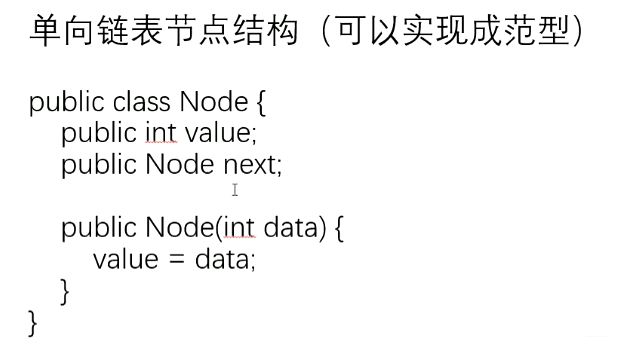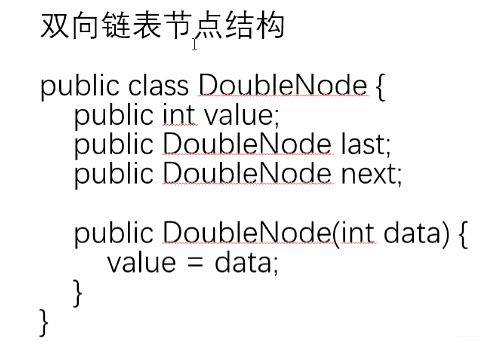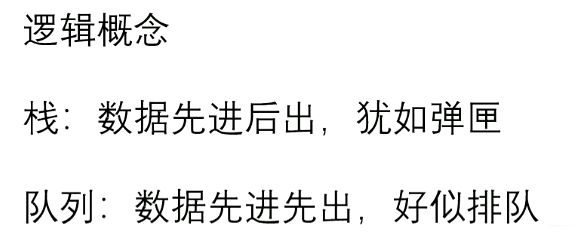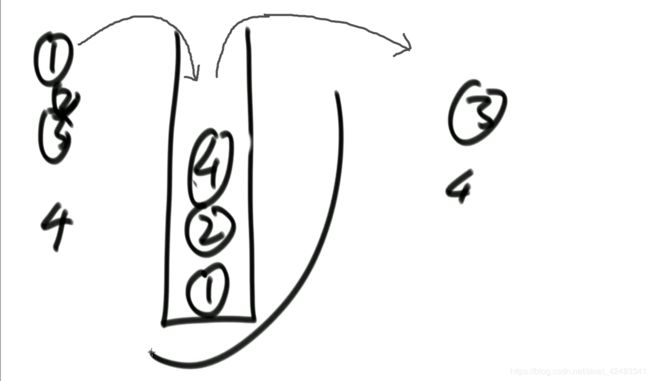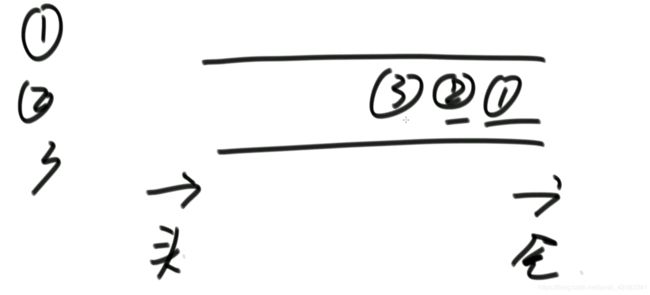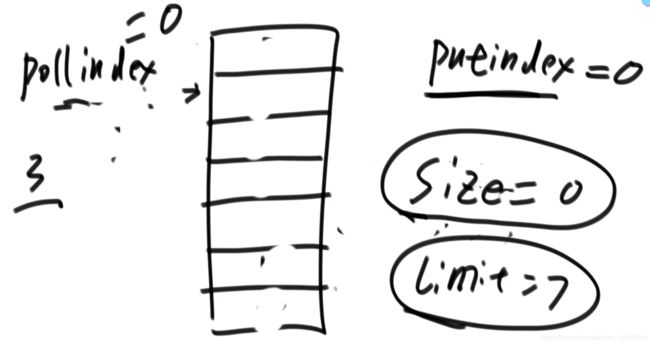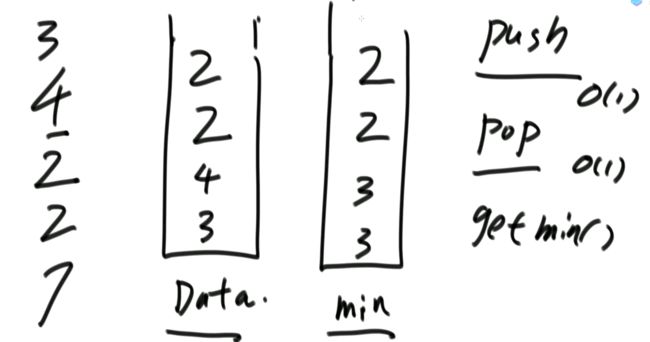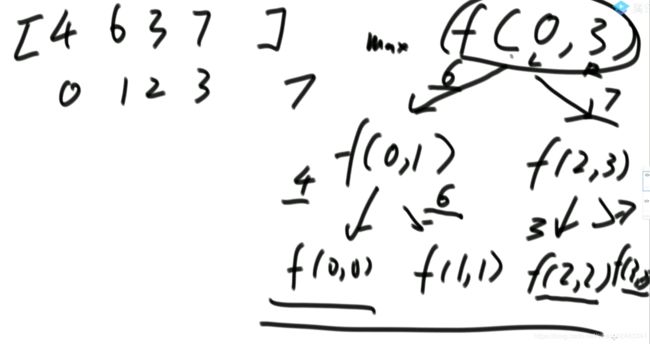左神算法课笔记(二):链表、栈和队列、递归Master公式、哈希表、有序表
单向链表
双向链表
单链表、双链表最简单的面试题
1、单链表和双链表如何反转
package class02;
import java.util.ArrayList;
public class Code01_ReverseList {
public static class Node {
public int value;
public Node next;
public Node(int data) {
value = data;
}
}
public static class DoubleNode {
public int value;
public DoubleNode last;
public DoubleNode next;
public DoubleNode(int data) {
value = data;
}
}
public static Node reverseLinkedList(Node head) {
Node pre = null;
Node next = null;
while (head != null) {
next = head.next;
head.next = pre;
pre = head;
head = next;
}
return pre;
}
public static DoubleNode reverseDoubleList(DoubleNode head) {
DoubleNode pre = null;
DoubleNode next = null;
while (head != null) {
next = head.next;
head.next = pre;
head.last = next;
pre = head;
head = next;
}
return pre;
}
public static Node testReverseLinkedList(Node head) {
if (head == null) {
return null;
}
ArrayList<Node> list = new ArrayList<>();
while (head != null) {
list.add(head);
head = head.next;
}
list.get(0).next = null;
int N = list.size();
for (int i = 1; i < N; i++) {
list.get(i).next = list.get(i - 1);
}
return list.get(N - 1);
}
public static DoubleNode testReverseDoubleList(DoubleNode head) {
if (head == null) {
return null;
}
ArrayList<DoubleNode> list = new ArrayList<>();
while (head != null) {
list.add(head);
head = head.next;
}
list.get(0).next = null;
DoubleNode pre = list.get(0);
int N = list.size();
for (int i = 1; i < N; i++) {
DoubleNode cur = list.get(i);
cur.last = null;
cur.next = pre;
pre.last = cur;
pre = cur;
}
return list.get(N - 1);
}
public static Node generateRandomLinkedList(int len, int value) {
int size = (int) (Math.random() * (len + 1));
if (size == 0) {
return null;
}
size--;
Node head = new Node((int) (Math.random() * (value + 1)));
Node pre = head;
while (size != 0) {
Node cur = new Node((int) (Math.random() * (value + 1)));
pre.next = cur;
pre = cur;
size--;
}
return head;
}
public static DoubleNode generateRandomDoubleList(int len, int value) {
int size = (int) (Math.random() * (len + 1));
if (size == 0) {
return null;
}
size--;
DoubleNode head = new DoubleNode((int) (Math.random() * (value + 1)));
DoubleNode pre = head;
while (size != 0) {
DoubleNode cur = new DoubleNode((int) (Math.random() * (value + 1)));
pre.next = cur;
cur.last = pre;
pre = cur;
size--;
}
return head;
}
// 要求无环,有环别用这个函数
public static boolean checkLinkedListEqual(Node head1, Node head2) {
while (head1 != null && head2 != null) {
if (head1.value != head2.value) {
return false;
}
head1 = head1.next;
head2 = head2.next;
}
return head1 == null && head2 == null;
}
// 要求无环,有环别用这个函数
public static boolean checkDoubleListEqual(DoubleNode head1, DoubleNode head2) {
boolean null1 = head1 == null;
boolean null2 = head2 == null;
if (null1 && null2) {
return true;
}
if (null1 ^ null2) {
return false;
}
if (head1.last != null || head2.last != null) {
return false;
}
DoubleNode end1 = null;
DoubleNode end2 = null;
while (head1 != null && head2 != null) {
if (head1.value != head2.value) {
return false;
}
end1 = head1;
end2 = head2;
head1 = head1.next;
head2 = head2.next;
}
if (head1 != null || head2 != null) {
return false;
}
while (end1 != null && end2 != null) {
if (end1.value != end2.value) {
return false;
}
end1 = end1.last;
end2 = end2.last;
}
return end1 == null && end2 == null;
}
public static void main(String[] args) {
int len = 50;
int value = 100;
int testTime = 100000;
for (int i = 0; i < testTime; i++) {
Node node1 = generateRandomLinkedList(len, value);
Node reverse1 = reverseLinkedList(node1);
Node back1 = testReverseLinkedList(reverse1);
if (!checkLinkedListEqual(node1, back1)) {
System.out.println("oops!");
break;
}
DoubleNode node2 = generateRandomDoubleList(len, value);
DoubleNode reverse2 = reverseDoubleList(node2);
DoubleNode back2 = testReverseDoubleList(reverse2);
if (!checkDoubleListEqual(node2, back2)) {
System.out.println("oops!");
break;
}
}
System.out.println("finish!");
}
}
2、把给定值都删除
package class02;
public class Code02_DeleteGivenValue {
public static class Node {
public int value;
public Node next;
public Node(int data) {
this.value = data;
}
}
public static Node removeValue(Node head, int num) {
while (head != null) {
if (head.value != num) {
break;
}
head = head.next;
}
// head来到 第一个不需要删的位置
Node pre = head;
Node cur = head;
//
while (cur != null) {
if (cur.value == num) {
pre.next = cur.next;
} else {
pre = cur;
}
cur = cur.next;
}
return head;
}
}
栈和队列
- 双向链表实现(头指针、尾指针)提供四种方法:从头部进、从头部出、从尾部进、从尾部出
- 数组实现
1、双向链表实现
package class02;
import java.util.LinkedList;
import java.util.Queue;
import java.util.Stack;
public class Code03_DoubleEndsQueueToStackAndQueue {
public static class Node<T> {
public T value;
public Node<T> last;
public Node<T> next;
public Node(T data) {
value = data;
}
}
public static class DoubleEndsQueue<T> {
public Node<T> head;
public Node<T> tail;
public void addFromHead(T value) {
Node<T> cur = new Node<T>(value);
if (head == null) {
head = cur;
tail = cur;
} else {
cur.next = head;
head.last = cur;
head = cur;
}
}
public void addFromBottom(T value) {
Node<T> cur = new Node<T>(value);
if (head == null) {
head = cur;
tail = cur;
} else {
cur.last = tail;
tail.next = cur;
tail = cur;
}
}
public T popFromHead() {
if (head == null) {
return null;
}
Node<T> cur = head;
if (head == tail) {
head = null;
tail = null;
} else {
head = head.next;
cur.next = null;
head.last = null;
}
return cur.value;
}
public T popFromBottom() {
if (head == null) {
return null;
}
Node<T> cur = tail;
if (head == tail) {
head = null;
tail = null;
} else {
tail = tail.last;
tail.next = null;
cur.last = null;
}
return cur.value;
}
public boolean isEmpty() {
return head == null;
}
}
public static class MyStack<T> {
private DoubleEndsQueue<T> queue;
public MyStack() {
queue = new DoubleEndsQueue<T>();
}
public void push(T value) {
queue.addFromHead(value);
}
public T pop() {
return queue.popFromHead();
}
public boolean isEmpty() {
return queue.isEmpty();
}
}
public static class MyQueue<T> {
private DoubleEndsQueue<T> queue;
public MyQueue() {
queue = new DoubleEndsQueue<T>();
}
public void push(T value) {
queue.addFromHead(value);
}
public T poll() {
return queue.popFromBottom();
}
public boolean isEmpty() {
return queue.isEmpty();
}
}
public static boolean isEqual(Integer o1, Integer o2) {
if (o1 == null && o2 != null) {
return false;
}
if (o1 != null && o2 == null) {
return false;
}
if (o1 == null && o2 == null) {
return true;
}
return o1.equals(o2);
}
public static void main(String[] args) {
int oneTestDataNum = 100;
int value = 10000;
int testTimes = 100000;
for (int i = 0; i < testTimes; i++) {
MyStack<Integer> myStack = new MyStack<>();
MyQueue<Integer> myQueue = new MyQueue<>();
Stack<Integer> stack = new Stack<>();
Queue<Integer> queue = new LinkedList<>();
for (int j = 0; j < oneTestDataNum; j++) {
int nums = (int) (Math.random() * value);
if (stack.isEmpty()) {
myStack.push(nums);
stack.push(nums);
} else {
if (Math.random() < 0.5) {
myStack.push(nums);
stack.push(nums);
} else {
if (!isEqual(myStack.pop(), stack.pop())) {
System.out.println("oops!");
}
}
}
int numq = (int) (Math.random() * value);
if (stack.isEmpty()) {
myQueue.push(numq);
queue.offer(numq);
} else {
if (Math.random() < 0.5) {
myQueue.push(numq);
queue.offer(numq);
} else {
if (!isEqual(myQueue.poll(), queue.poll())) {
System.out.println("oops!");
}
}
}
}
}
System.out.println("finish!");
}
}
2、数组实现
package class02;
public class Code04_RingArray {
public static class MyQueue {
private int[] arr;
private int pushi;
private int polli;
private int size;
private final int limit;
public MyQueue(int limit) {
arr = new int[limit];
pushi = 0;
polli = 0;
size = 0;
this.limit = limit;
}
public void push(int value) {
if (size == limit) {
throw new RuntimeException("栈满了,不能再加了");
}
size++;
arr[pushi] = value;
pushi = nextIndex(pushi);
}
public int pop() {
if (size == 0) {
throw new RuntimeException("栈空了,不能再拿了");
}
size--;
int ans = arr[polli];
polli = nextIndex(polli);
return ans;
}
public boolean isEmpty() {
return size == 0;
}
// 如果现在的下标是i,返回下一个位置
private int nextIndex(int i) {
return i < limit - 1 ? i + 1 : 0;
}
}
}
3、实现一个特殊额栈
普通栈正常使用,最小栈存放的是每一个状态下当前数的最小值
普通栈和最小栈同步push、pop,只不过给用户返回的是普通栈里的内容
4、如何用队列实现一个栈
两个队列,都是从头进、从尾出
data队列
help队列
例如,现在要push进1,2,3,4,5

现在要 pop 1,2,3,4,5
(除了最后一个数5以外,剩余的移动到help队列中,留下5用来给用户返回,更改data队列和help队列的属性,这样以此类推)

package class02;
import java.util.Stack;
public class Code06_TwoStacksImplementQueue {
public static class TwoStacksQueue {
public Stack<Integer> stackPush;
public Stack<Integer> stackPop;
public TwoStacksQueue() {
stackPush = new Stack<Integer>();
stackPop = new Stack<Integer>();
}
// push栈向pop栈倒入数据
private void pushToPop() {
if (stackPop.empty()) {
while (!stackPush.empty()) {
stackPop.push(stackPush.pop());
}
}
}
public void add(int pushInt) {
stackPush.push(pushInt);
pushToPop();
}
public int poll() {
if (stackPop.empty() && stackPush.empty()) {
throw new RuntimeException("Queue is empty!");
}
pushToPop();
return stackPop.pop();
}
public int peek() {
if (stackPop.empty() && stackPush.empty()) {
throw new RuntimeException("Queue is empty!");
}
pushToPop();
return stackPop.peek();
}
}
public static void main(String[] args) {
TwoStacksQueue test = new TwoStacksQueue();
test.add(1);
test.add(2);
test.add(3);
System.out.println(test.peek());
System.out.println(test.poll());
System.out.println(test.peek());
System.out.println(test.poll());
System.out.println(test.peek());
System.out.println(test.poll());
}
}
5、如何用栈实现一个队列
维护两个栈:
push栈,pop栈
现用户给我1,2,3,4,5
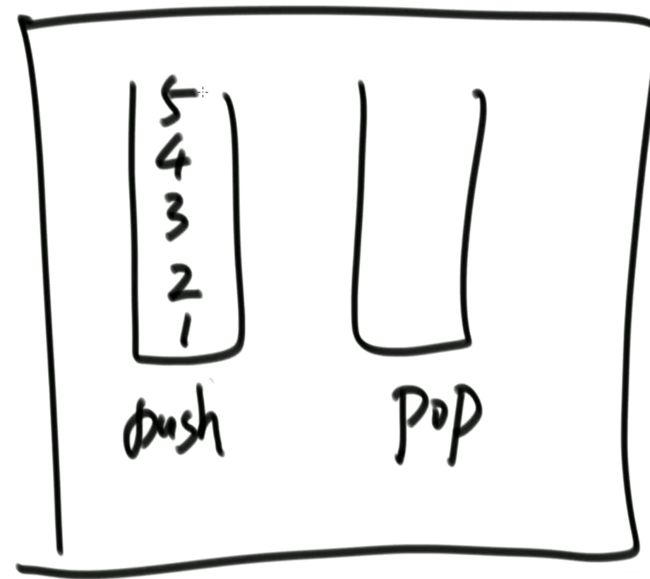
现在我要pop
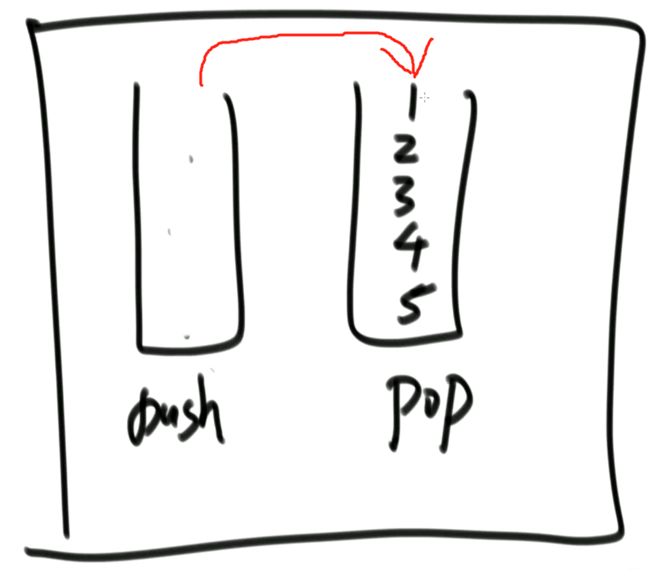
(1)pop栈为空的时候才能往外导数据
(2)如果决定导数据,push栈在导的过程中要一次性的导完

只要满足上面两个原则,不管什么时候导数据,都是对的
package class02;
import java.util.LinkedList;
import java.util.Queue;
import java.util.Stack;
public class Code07_TwoQueueImplementStack {
public static class TwoQueueStack<T> {
public Queue<T> queue;
public Queue<T> help;
public TwoQueueStack() {
queue = new LinkedList<>();
help = new LinkedList<>();
}
public void push(T value) {
queue.offer(value);
}
public T poll() {
while (queue.size() > 1) {
help.offer(queue.poll());
}
T ans = queue.poll();
Queue<T> tmp = queue;
queue = help;
help = tmp;
return ans;
}
public T peek() {
while (queue.size() > 1) {
help.offer(queue.poll());
}
T ans = queue.poll();
help.offer(ans);
Queue<T> tmp = queue;
queue = help;
help = tmp;
return ans;
}
public boolean isEmpty() {
return queue.isEmpty();
}
}
public static void main(String[] args) {
System.out.println("test begin");
TwoQueueStack<Integer> myStack = new TwoQueueStack<>();
Stack<Integer> test = new Stack<>();
int testTime = 1000000;
int max = 1000000;
for (int i = 0; i < testTime; i++) {
if (myStack.isEmpty()) {
if (!test.isEmpty()) {
System.out.println("Oops");
}
int num = (int) (Math.random() * max);
myStack.push(num);
test.push(num);
} else {
if (Math.random() < 0.25) {
int num = (int) (Math.random() * max);
myStack.push(num);
test.push(num);
} else if (Math.random() < 0.5) {
if (!myStack.peek().equals(test.peek())) {
System.out.println("Oops");
}
} else if (Math.random() < 0.75) {
if (!myStack.poll().equals(test.pop())) {
System.out.println("Oops");
}
} else {
if (myStack.isEmpty() != test.isEmpty()) {
System.out.println("Oops");
}
}
}
}
System.out.println("test finish!");
}
}
递归
例子
下面这个解法的复杂度是O(n)
package class02;
public class Code08_GetMax {
// 求arr中的最大值
public static int getMax(int[] arr) {
return process(arr, 0, arr.length - 1);
}
// arr[L..R]范围上求最大值 L ... R N
public static int process(int[] arr, int L, int R) {
if (L == R) { // arr[L..R]范围上只有一个数,直接返回,base case
return arr[L];
}
int mid = L + ((R - L) >> 1); // 中点 1
int leftMax = process(arr, L, mid);
int rightMax = process(arr, mid + 1, R);
return Math.max(leftMax, rightMax);
}
}
递归在语言上是怎么实现的?
递归实际上是运用的系统栈
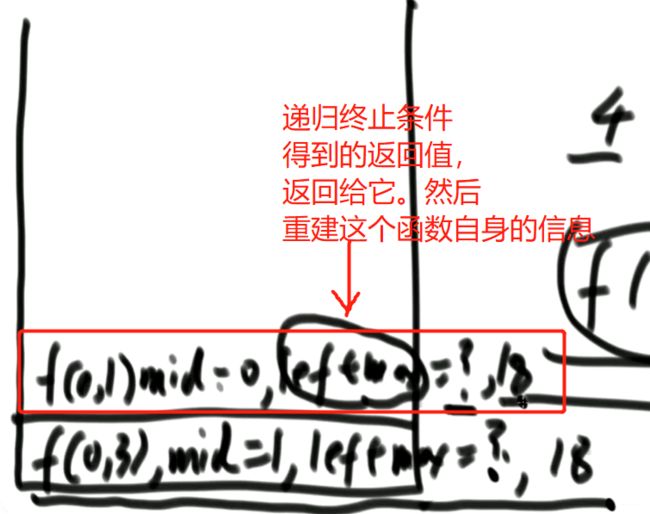 任何递归都可以改成非递归。
任何递归都可以改成非递归。
“尾递归”是一些语言对递归行为进行的优化,在底层执行的过程中已经是迭代了。
对于某一类递归,它的时间复杂度是可以直接确定的:
子问题的规模是N/b,子问题被调用a次,除去递归调用过程之外剩下所有行为的时间复杂度是O(n^d)
哈希表 HashMap
有序表 TreeMap
有序表的特点在于,你可以乱序插入元素,但他自己内部是有序的。
但是它的时间复杂度是O(logn)
有序表的底层实现可以是AVL树/SB树/红黑树,或跳表
非基础类型在有序表中,怎么比较大小?以后会在堆的章节讲。
package class02;
import java.util.HashMap;
import java.util.HashSet;
import java.util.TreeMap;
public class HashMapAndSortedMap {
public static class Node{
public int value;
public Node(int v) {
value = v;
}
}
public static void main(String[] args) {
// UnSortedMap
HashMap<Integer, String> map = new HashMap<>();
map.put(1000000, "我是1000000");
map.put(2, "我是2");
map.put(3, "我是3");
map.put(4, "我是4");
map.put(5, "我是5");
map.put(6, "我是6");
map.put(1000000, "我是1000001");
System.out.println(map.containsKey(1));
System.out.println(map.containsKey(10));
System.out.println(map.get(4));
System.out.println(map.get(10));
map.put(4, "他是4");
System.out.println(map.get(4));
map.remove(4);
System.out.println(map.get(4));
// key
HashSet<String> set = new HashSet<>();
set.add("abc");
set.contains("abc");
set.remove("abc");
// 哈希表,增、删、改、查,在使用时,O(1)
System.out.println("=====================");
int a = 100000;
int b = 100000;
System.out.println(a == b);
Integer c = 100000;
Integer d = 100000;
System.out.println(c.equals(d));
Integer e = 127; // - 128 ~ 127
Integer f = 127;
System.out.println(e == f);
HashMap<Node, String> map2 = new HashMap<>();
Node node1 = new Node(1);
Node node2 = node1;
map2.put(node1, "我是node1");
map2.put(node2, "我是node1");
System.out.println(map2.size());
System.out.println("======================");
TreeMap<Integer, String> treeMap = new TreeMap<>();
treeMap.put(3, "我是3");
treeMap.put(4, "我是4");
treeMap.put(8, "我是8");
treeMap.put(5, "我是5");
treeMap.put(7, "我是7");
treeMap.put(1, "我是1");
treeMap.put(2, "我是2");
System.out.println(treeMap.containsKey(1));
System.out.println(treeMap.containsKey(10));
System.out.println(treeMap.get(4));
System.out.println(treeMap.get(10));
treeMap.put(4, "他是4");
System.out.println(treeMap.get(4));
treeMap.remove(4);
System.out.println(treeMap.get(4));
System.out.println(treeMap.firstKey());
System.out.println(treeMap.lastKey());
// <= 4
System.out.println(treeMap.floorKey(4));
// >= 4
System.out.println(treeMap.ceilingKey(4));
// O(logN)
}
}
